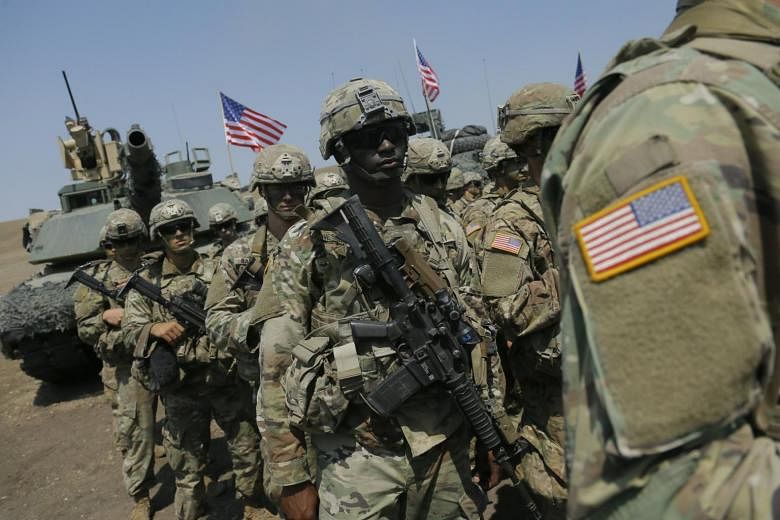WASHINGTON (REUTERS) - The United States military has contingency plans for responding to any North Korean attack that are constantly updated and range from cyber efforts to all-out nuclear retaliation.
While the plans are highly classified, experts and officials say they carry considerable risks and the potential for heavy losses of life.
NUMBERS AND CAPABILITIES
The US military has an aircraft carrier, the USS Ronald Reagan, deployed to Yokosuka, Japan. According to the Federation of American Scientists, the US has about 1,800 nuclear warheads deployed on intercontinental ballistic missiles (ICBMs) and submarines.
USS Ronald Reagan has a crew of 5,000, around 80 aircraft, and is equipped with the latest targeting and defense radars, integrated weapons systems and command and communications technology.
Six B-1 bombers are now stationed at Andersen Air Force base in the US Pacific territory of Guam.
According to the Arms Control Association, the US has 1,411 strategic nuclear warheads deployed on a total of 673 ICBMs, submarine-launched ballistic missiles (SLBMs) and strategic bombers.
North Korea has conducted five nuclear tests, including two last year, and dozens of missile tests in the past year. In April, experts at 38 North, a North Korean monitoring project, estimated that North Korea could have as many as 20 nuclear warheads and could produce one more each month.
North Korea has a broad spectrum of missiles in its arsenal, with ranges from 150km to 8,000km.
According to the Centre for Strategic and International Studies, North Korea's short- and medium-range systems include a host of artillery and short-range rockets, including Scud missiles, No-Dong systems, and a newer mobile solid-fuelled SS-21 variant called the KN-02. It has made strides in long-range missile technology and tested a first ICBM, the Hwasong-14, in July.
Although North Korea has more than a million troops, hundreds of military aircraft and air defence systems, experts question their capabilities.
Mr Anthony Cordesman of Washington's Centre for Strategic and International Studies said South Korea's F-15 and F-16 fighter jets are far more capable than North Korea's outdated MiGs and Su-25 jets.
North Korean air defences such as the SA-5 and the SA-3 surface-to-air missiles are "essentially Vietnam War-vintage systems, he said, making Pyongyang "very vulnerable to stealth and cruise missile attacks".
Also, Pyongyang's conventional forces rely on obsolete equipment. "Exercises are regularly conducted, but they often appear staged and as such are not necessarily representative of wider operational capability," a 2017 report from the International Institute for Strategic Studies said.
CONSIDERATIONS AHEAD OF AN ATTACK
Before launching a full-scale attack against North Korea or a surgical strike against key targets, the US would first have to consider evacuating American citizens and alerting its allies for fear of North Korean counterattacks, US officials and experts said.
That, as well as positioning the forces for a major attack, would wipe out the element of surprise, in part because the North Koreans are believed to have a number of spies in South Korea and elsewhere, US intelligence officials said.
The first phase of an attack would be a Suppression of Enemy Air Defences (SEAD) campaign to clear the way for air strikes. A SEAD campaign uses air strikes, artillery, missiles, or all the options, to destroy an enemy's anti-aircraft defences.
Even a conventional clash could cause catastrophic casualties, given the thousands of North Korean artillery pieces ranged along the border, at least 1,000 of which are capable of reaching the densely populated South Korean capital Seoul and its metropolitan area, home to some 25 million people.
POTENTIAL OBSTACLES AND COMPLICATIONS
Officials and experts say while the US could hit targets, there are serious questions as to whether they have accurate enough intelligence to strike all of North Korea's potential weapon sites before Pyongyang responds, especially given its development of mobile missile launch systems.
"First, we simply do not have a comprehensive or precise picture of the North Korean nuclear programme, especially when it comes to the number of weapons and delivery vehicles - we do not know for sure where they are located or how well they are protected," a 2016 Stratfor report said.
Vice-Chairman of the US Joint Chiefs of Staff General Paul Selva said recently: "I'm reasonably confident in the ability of our intelligence community to monitor the testing, but not the deployment, of these missile systems.
"Kim Jong Un and his forces are very good at camouflage, concealment and deception."
US officials say the unpredictability of North Korea's response makes any military option risky. How neighbouring China would respond is also a question military planners would have to address.
US military officials have publicly warned against a military conflict because of the catastrophic loss of life it would lead to, saying diplomatic efforts are the priority.
"You can see the American effort is diplomatically led. It has diplomatic traction. The tragedy of war is well enough known, it does not need another characterisation beyond the fact that it would be catastrophic," US Defence Secretary James Mattis said last week.

